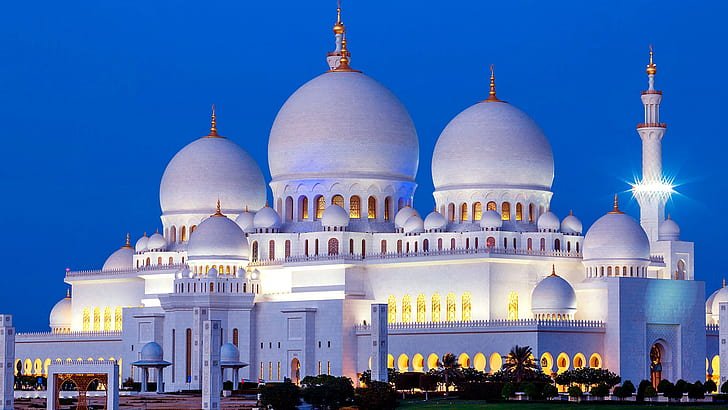The majestic Grand Mosque of Abu Dhabi
Sheikh Zayed Grand Mosque, Abu Dhabi.
Mesmerized, I looked around me. Modern architectural marvels had risen from the sands. In front of my eyes was the challenge of architecture! I was in Abu Dhabi.
Abu Dhabi in 1948.
But let history reveal to us its astonishing transformation from a modest port to one of the world’s wealthiest cities.
In the past, it was a tiny Bedouin fishing and pearl diving port on the shores of the Persian Gulf. At the start of the pearling season, which was from June to September, Bedouins, who were engaged in the pearl diving activity, used to leave their homes in the oases of the desert and gather on the coast, where hundreds of local boats were ready to disembark with all the necessary provisions to last for up to three months. After the customary rites to charm the sharks so they would not harm the divers, the boats dispersed on the windless, calm sea.
Pearl diving in the Persian Gulf.
Thus, the pearling industry was the main driver of the economy of Abu Dhabi, due to the huge demand by the Indian and European markets. But in the late 1920s economic disaster struck. High-quality Japanese cultured pearls, produced in commercial quantities, flooded international markets. This change, along with the Great Depression of 1929 was devastating for the local economy.
However, the sea, and then the desert, held the miracle! Under the old pearling bed in the Persian Gulf, oil was discovered in 1958, and two years later (1960) in the desert. The first cargo of crude was exported in 1962. As oil revenues increased, the ruler of Abu Dhabi, Sheikh Zayed bin Sultan Al Nahyam, undertook a massive construction program building schools, hospitals, houses, and roads to improve his people’s quality of life.
The Aldar Headquarters Building is the first circular building of its kind in the Middle East.
Today Abu Dhabi, the capital of the United Arab Emirates, is known not only for its prosperity and cultural contribution to the Middle East region but also for its architectural wonders.
The Louvre Abu Dhabi - Image Credit: Abdul Rahman/Gulf News.
Sheikh Zayed Grand Mosque.
The star attraction of the city is the Sheikh Zayed Grand Mosque and, although it attracts millions of people every year, an air of serenity surrounds it. It was named after Sheikh Zayed bin Sultan Al Nayam, ruler of Abu Dhabi, who was the first President of the United Arab Emirates, and is revered as the “Father of the Nation”.
Sheikh Zayed’s discussions about the Mosque.
He conceived the idea of the Mosque and took over the architectural direction of the project with his desire for it to be his final resting place. After his death in 2004, his body was buried in the courtyard.
Sheikh Zayed Grand Mosque, courtyard.
The spectacular monument was designed by Syrian architect Yousef Abdelky. Inspired by Persian, Mughal, and Moorish architecture, it was a truly international collaboration of more than 3,000 craftsmen from 38 global construction companies.
The Grand Mosque is comprised of 82 domes.
It stands as one of the most grand and lavish creations in all of the UAE. Work began in 1994 and took 12 years to complete at a reported cost of around $545 million. It is the third-largest mosque in the Islamic world covering, an area equivalent to nearly four football fields and it holds more than 40,000 worshippers. It has three Guinness World Records for the largest hand-woven floral prayer carpet -weight 35 tons- the biggest chandelier as well as the largest dome of its kind in the world, plus 82 smaller white marble domes and millions of crystals.
Sheer beauty and grandeur in the prayer hall.
The intricately designed floral hand-woven prayer carpet.
Its real opulence, though, is in the tiny details such as semi-precious stones, amethyst, and jasper, embedded in intricate floral motifs. These exquisitely made little flowers are crafted into the 1,096 exterior columns and the 96 internal columns.
The interior courtyard features the world’s largest marble mosaic.
British artist and illustrator Devin Dean, who had worked with the Natural History Museum in London and came up with the floral designs that adorn the Mosque, describes being involved in one of the most exciting architectural projects in the world. He was appointed by Sheikh Sultan bin Zayed (son of the late Sheikh Zayed bin Sultan Al Nahyan) who was also responsible for overseeing the mosque’s construction.
“I sent my portofolio across, and a few days later, I was on the plane to Abu Dhabi to meet the Sheikh”, he recalls. He was stunned to be given free rein on the project. “I was lucky to have creative freedom for such a project”.
Floral patterns with semi precious stones.
He made frequent trips to Italy to see the designs being made, where more than 30 million pieces of marble were needed for the inlaid flowers. Italy has had the longest tradition in this type of art since the Renaissance.
For the main courtyard, Dean used flowers that can be found in the Middle Eastern region. In the main prayer hall, the species come from the Middle East; at the northern entrance, they come from the Northern Hemisphere, while at the southern entrance, they come from the South.
One of the seven 24-carat gold-plated Swarovski chandeliers.
Before I entered the Grand Mosque, I was aware of all these details, but when I was inside, it was as if they all evaporated. Enchanted, I noticed that everything was amalgamated harmoniously and extremely aesthetically. The deep silence that reigned in the vast space which was illuminated by the seven 24-carat gold-plated Swarovski crystal chandeliers, wrapped its exquisite beauty.
I think that I chose the right time to visit the Mosque. It was when the sun was setting and the pure white color of its domes gradually took on deeper hues of pink.
The Grand Mosque’s spectacular illumination after dark.
When I went out, it was dark. The entire Mosque was illuminated offering my eyes a magical image. According to the phase of the moon, lights get darker or lighter. I raised my eyes to the sky thanking the Universe for inspiring the benefactors, along with all the architects and artists involved in its creation, and praising all the artisans who executed it. They offered the 21st century a masterpiece.
Travel with my Βooks in English















